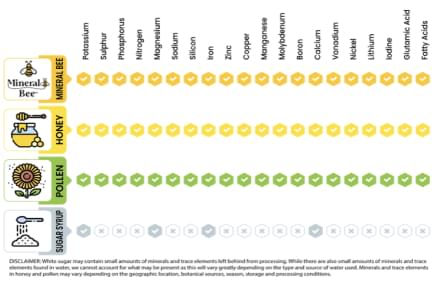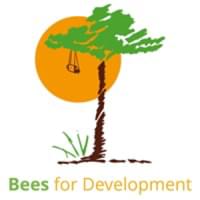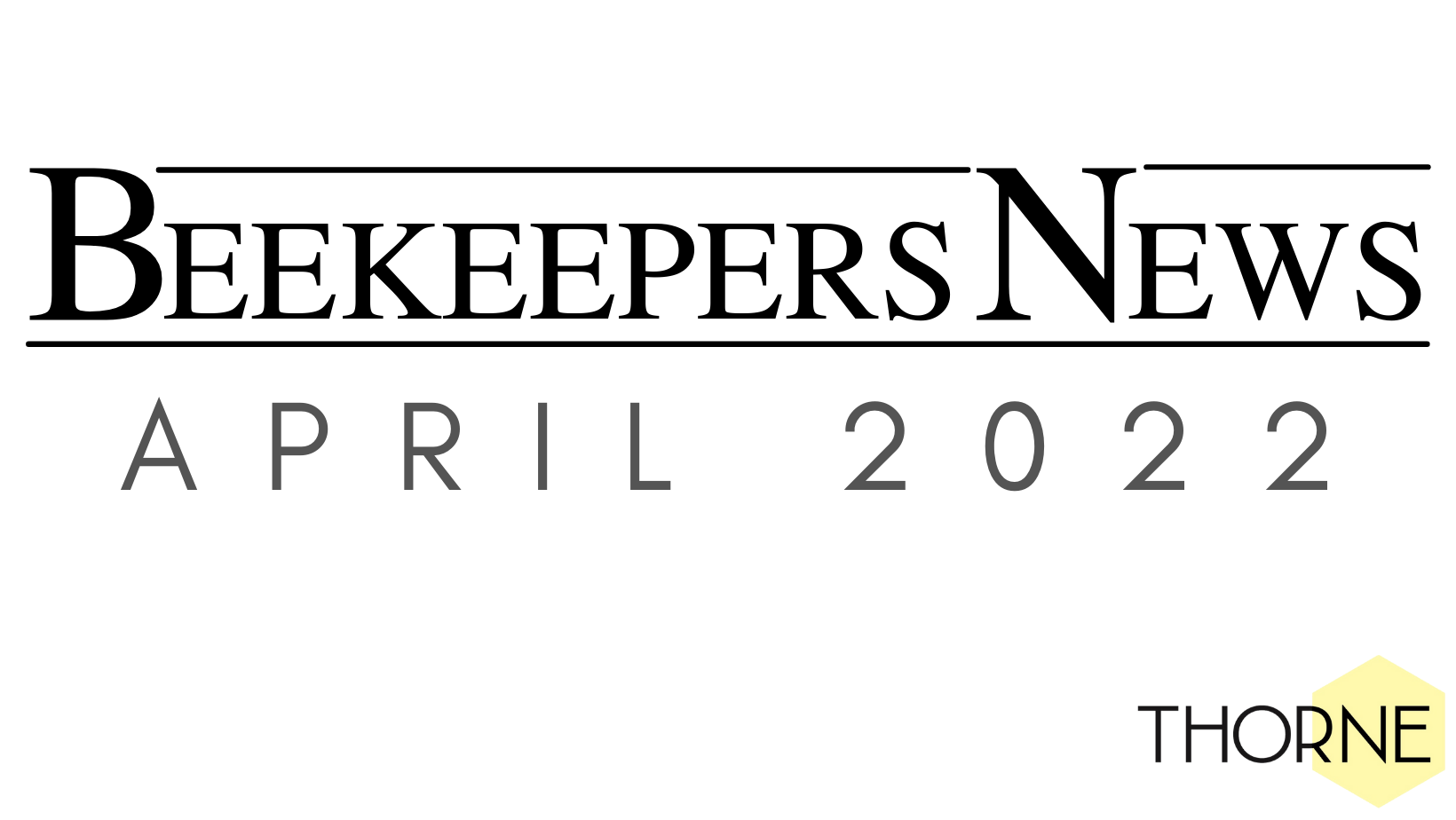
We start this month’s newsletter with this beautiful shot of our current view from our Head Office’s window. It is the best we’ve seen this particular cherry blossom in years, so hopefully that’s a good sign for the year ahead!
If you are yet to shop on our new website, please make sure you reset your password before putting any items into your basket. If you have any issues with this, you can contact us on Live Chat during office hours, or email sales@thorne.co.uk.
Planning a course in 2022? We now have our catalogue memory sticks, ready and loaded with our 2022 catalogue, information for beginners, and some helpful website links. Get in touch to order these, free of charge, for your course.
We were in Wales last weekend for our first show of the year, the Welsh Convention. It was lovely to be back there and see some familiar, and new, faces!

Our next show in the diary is the BBKA Spring Convention on Saturday 9th April. You can still place your order for collection from this show. If there is anything in particular you would like to see at the BBKA Spring Convention, please get in touch with us by emailing beekeeper@thorne.co.uk.
|
|
|
|
Equipment Focus
Bees on a Budget – The WBC

We are pleased to introduce our new range of WBC budget hives. Available ready assembled or in the flat for home assembly. The hives are made from British Western Red Cedar, sustainably sourced from FSC forests. British cedar is lighter in colour than Canadian cedar and may have small live knots or other slight imperfections. Frames are pine and are second quality. Assembled hives can also be painted. If you would like your hive painted, please choose the assembled hive option.
Each hive comprises of:
- Solid floor and legs
- Three lifts (one with porch and badge)
- Galvanised metal covered gabled roof with plastic cone escapes (Optional upgrade to copper)
- Brood body – including 10 DN4 frames with wired standard foundation
- Plastic dummy board
- Flat, slotted steel queen excluder
- Two supers - each including 11 SN4 frames with wired standard foundation
- Crownboard - with two plastic porter bee escapes
- Metal runners
- Pair of entrance slides
- Cavity lath
- All nails, glue, and full instructions (if ordered in flat pack)
|
|
|
Special Offers
Hive Intrance
The Upstairs Downstairs Intrance (internal entrance) gives the bees the ability to effectively defend themselves against robbing, wax moth, wasps, and rodents. The complete kit includes a well-researched booklet, four Intrances, four ventilated bungs, four blank bungs, hole cutter, fixing screws and screwdriver.
£24 £20
We are also offering 10% off Mineral Bee for the month of April. Mineral Bee is 100% natural minerals, trace elements, amino acids, and fatty acids for honeybees and has been scientifically proven to contain the same key minerals and trace elements as honey and pollen. You can read all about the story of Mineral Bee below, as told by George McGee, developer of Mineral Bee.
|
|
|

I have been a beekeeper since I was 8 years old. In fact, I purchased my first smoker from Thorne in 1972! I moved to Australia in 2005. I am a semi commercial beekeeper in Sydney NSW.
I developed Mineral Bee in 2019 after researching for many years the importance of minerals and trace elements for bees.
“Minerals and trace elements are key to the successful operation of insects.” Julian A T Dow 2017: 23 1-8. University of Glasgow.
Minerals and Trace elements FOR BEES has been scientifically proven to contain the same key minerals and trace elements as honey and pollen.

It contains 23 minerals and trace elements plus amino acids and fatty acids sourced from concentrated ocean minerals. It is not seaweed.
When you add this amazing concentrate of 100% natural organically sourced essential minerals and trace elements to your syrup feed, drinking water, fondant, or pollen patties you are restoring very important nutritional value to your bee’s diet and helping aid colony strength.
There is no brewing involved in the production of this product, so it is very shelf stable and has a long shelf life even when opened.
It is colourless and odourless.
It is important to note sugar syrup has almost no nutritional value except carbohydrates so it important for the bee’s health to add minerals and trace elements FOR BEES to the syrup feed. Please see graph below.
Directions for use: Simply add 10 ml to every 1 litre of your bee’s syrup feed or drinking water and stir. You can also add 10 ml to 1 kg of pollen patty or fondant. Use whenever you are feeding your bees or providing drinking water
- George McGee (developer of Mineral Bee Minerals and Trace Elements FOR BEES).
 |
|
|
|
Blog
March
As expected, March has been a month of more activity in the apiary. With plenty of warm weather towards the end of the month, we were able to go into the hives to check them for stores and see which colonies were doing well and which ones needed a bit more help.
You can see from these pictures that there are plenty of bees in this colony and also lots of them leaving the hive to forage. Bees are covering roughly 7 frames, 8 at a push, which we find acceptable for this time of year.

For some of the smaller colonies, we have continued to feed pollen patties as March is still quite early on in the season. We hope this will give them a boost to go strongly into the spring. We have used a mixture of the Thorne Bee Patty and Hive Alive fondant to see if there is any difference in outcome for the bees or if they prefer one over the other.

We have had one ‘disaster’ this month. A mouse got into one of our colonies – not through the entrance but through the roof! On examining one colony in a twinstock, one side which would have had 6 frames in had been thoroughly chewed through. You can see here how much wax is missing from these frames!
What we believe has happened is upon last inspection, the crownboard was placed down on top of this nut or seed and then when the roof was placed back on top, it didn’t sit exactly flush, leaving a tiny gap just big enough for a mouse to enter.

The mouse has chewed some of the wood in the roof and made quite a mess on top of the crownboard! You can see in the last picture here that the twinstock still has bees in one side, so clearly the mouse just managed to get in one side. All from one tiny little gap in the roof!

So that is one lesson learned – double check that crownboards and roofs sit absolutely flush!
Aside from that, the bees look to be coming along nicely and we hope to keep building them up as April progresses. We have noticed there is a field of oil seed rape very close by which will give the bees an excellent source of nectar and pollen heading into the main active season.
|
|
|
Book Review
‘The Hopkins Method for Raising Queens in your Small Apiary’ By Joe Conti

Book review by Mary Montaut:
‘The Hopkins Method for Raising Queens in your Small Apiary’
By Joe Conti
Published 2021 by Northern Bee Books
ISBN: 978-1-914934-25-4
244 x 170 mm, 38 pp
£11.95 from northernbeebooks.co.uk
I found this short book most interesting, as I had not previously encountered the ‘Hopkins Method’ of queen rearing. It is extremely simple and practical, which may make it a useful tool in the armory of beekeeping, especially as it seems to be based on quite an unusual premise. The basic method is to place a frame of brood, from a colony selected for good characteristics, horizontally into another hive which will raise good queens from it. In short, to place the frame from the Donor colony above the brood of the Recipient colony. Is sounds so simple that I was naturally very suspicious about it. I would be most interested to know whether anyone in Ireland has ever come across this method, which was first developed in New Zealand by Isaac Hopkins in 1911 (published in the Illustrated Australasian Bee Manual and Complete Guide to Modern Bee Culture in the Southern Hemisphere). It has also been published more recently in the American Bee Journal (1984, 1991 and 2021). However, Joe Conti describes every step and stage of the process in a clear and simple way, and I found myself being drawn into wondering whether it really could help with the all-too-common problem of a hive that has gone queenless, as he suggests. If for no other reason than this, I would recommend that Associations might consider investing in a copy of this book for their library, as I expect it would interest one or two members enough to try the Method. An association might even consider it as a sort of trial, as our climate and our bees are not the Italians with which I expect the original author (and probably Mr Conti himself) was working. Very briefly, then, a deeper and usual eke is placed over the brood chamber in the queenless Recipient colony, into which a prepared brood frame from the Donor colony is placed horizontally for the bees to produce queen cells from it. Obviously, the preparation and timing are critical, and well explained. The expectation is that the new queens so produced will be of a superior quality.
The author also covers introducing the new queens into other colonies as needed. I think there is not a single word wasted in this little publication, and the photos are very helpful and clear. At the end Conti addresses a query which I expect he had received more than once about the quality of the local drones. His answer is truly a beekeeper’s one: that at least you’d have a good queen! And he suggests raising a frame of drone brood as well. Altogether, I found it very enjoyable to read this little tract in the middle of our Irish Winter. As I said, perhaps your Association might buy a copy for your adventurous member(s) to try this out.
- Review by Mary Montaut, editor of The Irish Beekeeper (An Beachaire).
|
|
|
|

Blog
Go easy monitoring your mites: New CO2 option for Varroa EasyCheck!
The decades-long fight of beekeepers against one of the biggest enemies of the apicultural industry still remains a big issue. The varroa mite, Varroa destructor, since its migration from the Asian honey bee (Apis cerana) onto the Western honey bee (Apis mellifera) in the 1960s and 1970s, is widely regarded as the most dangerous parasites of honeybee colonies.
Varroa mite populations in honeybee colonies build up in the honey bee brood every season and can never be completely eliminated in honey bee populations where they are present. Inevitably, beekeepers are faced with no choice, but to fight the mite constantly. This calls for strategic decisions and requires some planning ahead. Putting this into perspective, monitoring varroa has become a crucial everyday component of beekeeping today.
Monitoring allows beekeepers to avoid critical levels of varroa mite infestation and serves as a guide in effectively timing miticide applications. With our focus on apiculture, Veto-pharma made available the first ready-to-use “3 in 1” monitoring tool: Varroa EasyCheck. Alcohol wash, powdered sugar roll and CO2 injection are the three monitoring methods using the same tool – Varroa EasyCheck. Véto-pharma is pleased to inform you it has the injector and cartridge for the CO2 injection in stock now.

CO2 injection is a monitoring method that can be as effective as alcohol wash, but it leaves your sample of bees alive. The process is super clean and easy. This procedure also saves time as it has proven to be the fastest of all 3 methods. Unlike the sugar roll method, which can get messy (especially during honey flows, when bees can regurgitate the nectar, or during humid weather) and which may require more time, the CO2 injection method is quick (30 secs) and highly effective, comparatively.
The CO2 injection method for varroa monitoring is easy as pie: Collect a sample of 200 or 300 bees with the white basket, preferably from a frame of capped brood (make sure the queen is not in the sample). Place the yellow lid on top. Create a small opening between the yellow lid and the transparent container and inject the CO2 through the holes of the white basket for 5 seconds, until the bees stop flying. Do not inject directly toward the bees. Then, quickly close the lid. Let the Varroa EasyCheck sit for about 10 seconds, until the bees are anesthetised.
Turn the Varroa EasyCheck upside-down and gently shake the sample for 15 seconds, so you do not hurt the bees. Varroa mites will be dislodged from bees and fall through the holes of the basket. Open the yellow lid and count the mites inside. Calculate infestation rate per 100 bees, as for alcohol wash. Depending on if you took 200 or 300 bees divide the number of counted mites by 2 or 3 to get your infestation rate (in %). To interpret the results, please consult our Varroa Guide and/or your local thresholds. Put the bees back in the hive where they will recover. Dispose of the fallen varroa mites, as most will still be alive. Grab your tools (Varroa EasyCheck, injector, and cartridge), as we keep at it to defeat the mite and keep our bees safe.

|
|
|
|
Bees for Development

Double your donation in The Big Give Green Match Fund 22-29 April
We are seeking funds towards our work in the forests of south Uganda, where communities have suffered terribly through changes in land use and ownership - resulting in extreme poverty. Every donation you can give will be doubled from 12 noon Friday 22 - Friday 29 April.
www.beesfordevelopment.org
If you'd like to Support beekeepers in Ukraine...
Beekeepers in Ukraine will need so much help – from equipment to re-building community groups around bees. Please donate if you can.
As soon as it is possible, we will pass your donation to a beekeeping association in Ukraine to help their members re-establish their apiaries, restore their local environment and begin to re-build their livelihoods.
|
|
|
|
National Honey Show News April 2022
Ukraine Appeal
Message from our chairman "The National Honey Show has set up a Just Giving page to give UK beekeepers a focused way too show their support for Ukraine. Funds will go directly to the Disasters and Emergency Committee. The National Honey Show has a long association with the Brotherhood of Ukrainian Beekeepers and for ten years they sponsored the Medal of Ukraine as one of our trophies. This trophy will be immediately re-instated by the National Honey Show as a gesture of support for our Ukrainian friends."

Many thanks from the National Honey Show team for the fantastic, very generous support already received. We encourage everyone to share this project with beekeeping friends. Your support for Ukraine is much appreciated.
Our first Friday in April’s 2021 lecture video release was “Honeybee Behaviour” by Lynfa Davies.
By ‘subscribing’ for which there is no cost involved, you’ll receive updates whenever new content appears. So you’ll be among the first to hear about any bonus video postings.
2022 Provisional Lecture Programme
This year’s Fantastic Programme will include Lectures by Dara Kilmartin, Jeff Pettis, Dave Goulson, Richard Ridler, Nicola Bradbear, Grace McCormack, Willie Robson and Roger Patterson. There will also be Friday Bee Craft lectures from early career bee researchers, and the usual Saturday programme for those in their first years of beekeeping.
Look forward to seeing you all at the show later this year: Thursday 27 to Saturday 29th October 2022.
|
|
|
Upcoming Events
- 9th April – BBKA Spring Convention
- 12th & 13th August – Thornes of Scotland Sale Day
- 3rd September – Thornes of Windsor Sale Day
- 17th September – Thornes of Stockbridge Sale Day
- 24th September – Thornes of Devon Sale Day
- 8th October – Rand Sale and Open Day
- 27th - 29th October – The National Honey Show
|
|
|
|
